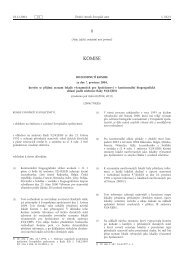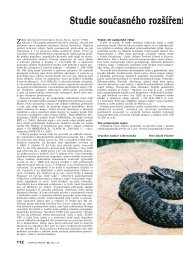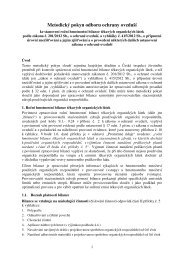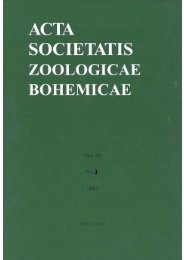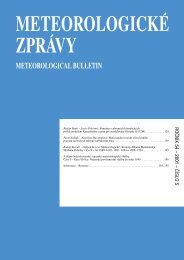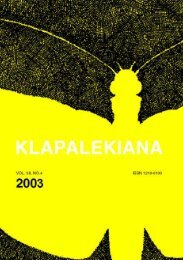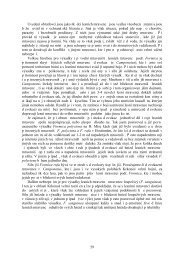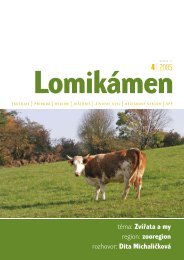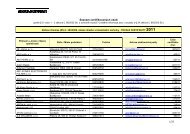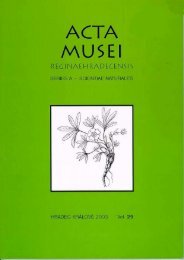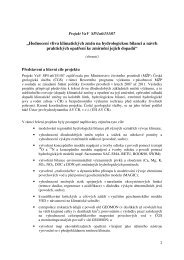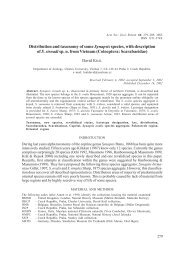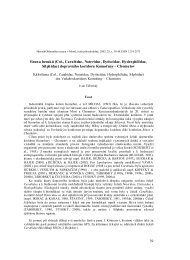journal of forest science
journal of forest science
journal of forest science
Create successful ePaper yourself
Turn your PDF publications into a flip-book with our unique Google optimized e-Paper software.
According to the method <strong>of</strong> model derivation we can<br />
distinguish:<br />
1. mechanical approach – it uses the knowledge and regularities<br />
from mechanics <strong>of</strong> construction degradation;<br />
2. empirical approach – it uses all knowledge about roadway<br />
degradation obtained empirically;<br />
3. combined mechanical and empirical approaches with<br />
application <strong>of</strong> theory and practical information.<br />
The roadway properties may be evaluated:<br />
a) in laboratory – by accelerated stress and testing,<br />
b) in real conditions – in a network <strong>of</strong> roads.<br />
However, the laboratory methods and measurements<br />
are not suitable for an independent empirical method. The<br />
method <strong>of</strong> degradation model combining mechanical and<br />
empirical approaches is used very <strong>of</strong>ten. The results <strong>of</strong><br />
laboratory tests <strong>of</strong> physical properties <strong>of</strong> the materials<br />
are the basis for evaluation <strong>of</strong> the construction (degradation)<br />
under accelerated testing for example on a circular<br />
and straight course but especially in a network <strong>of</strong> roads.<br />
The results from long-term measurements and observations<br />
(LTPP – long-term pavement performance) under<br />
real climatic conditions and wheel traffic are the most<br />
valuable. The relative time reduction to acquire needed<br />
data is possible by selection <strong>of</strong> suitable localities and<br />
conditions (their combination).<br />
Two types <strong>of</strong> models are needed as concerns the planning<br />
<strong>of</strong> roadway maintenance and renewal in the network<br />
<strong>of</strong> roads:<br />
– degradation models <strong>of</strong> new roadways,<br />
– degradation models <strong>of</strong> rehabilitated (renewed) roadways.<br />
We must distinguish the categories <strong>of</strong> “aggregated” and<br />
“segregated” models according to the fact whether the<br />
model reflects the aggregated evaluation <strong>of</strong> roadway condition<br />
or if it relates only the changes in a segregated<br />
parameter. The measurements for roadway renewal are<br />
several and therefore the models are “compound-combined”<br />
or “single-specific”.<br />
Degradation models based on aggregated coefficients<br />
– parameters can also be combined with different conditions.<br />
“The network analysers” are used for planning and<br />
roadway renewal in a network <strong>of</strong> roads as a whole. Other<br />
models are “specific” models for a selected section <strong>of</strong><br />
the road with some roadway composition in combination<br />
with the existing conditions on this object – climatic load<br />
and wheel traffic.<br />
or a prognosis <strong>of</strong> the course <strong>of</strong> roadway degradation<br />
the models and functions are needed which relate to segregated<br />
or aggregated evaluation <strong>of</strong>:<br />
– roughness <strong>of</strong> roadway surface,<br />
– evenness <strong>of</strong> roadway surface in square and longitudinal<br />
directions,<br />
– mechanical efficiency (bearing capacity) <strong>of</strong> roadway,<br />
– index <strong>of</strong> serviceability,<br />
– surface condition, intensity and degree <strong>of</strong> surface damage,<br />
– index <strong>of</strong> construction condition as well as other parameters.<br />
To evaluate the roadway condition it is possible to use<br />
two basic evaluation methods:<br />
a) diagnostic evaluation,<br />
b) visual evaluation.<br />
The combination <strong>of</strong> both methods is used most frequently.<br />
The visual evaluation <strong>of</strong> roadway surface is generally<br />
primary and it is complemented by diagnostic<br />
evaluation with special equipment.<br />
Degradation models and degradation functions for public<br />
roads in Slovakia are at their beginning for the time<br />
being due to a small number <strong>of</strong> measurements, they are<br />
in the phase <strong>of</strong> proposals. They will be based on the results<br />
<strong>of</strong> measurements on circular experimental roads <strong>of</strong><br />
VÚIS – Cesty, s.r.o., Bratislava and the results <strong>of</strong> visual<br />
evaluations on a highway section D 61. The situation in<br />
the Czech Republic is similar.<br />
The publication <strong>of</strong> the World Bank contains the prediction<br />
<strong>of</strong> roadway degradation, degradation models and<br />
functions with description <strong>of</strong> so-called HDM-III model<br />
(The Highway Design… 1987). There are presented the<br />
empirically determined relations for variable parameters<br />
(cracks, depth <strong>of</strong> tracks) in dependence on wheel traffic.<br />
These relations are defined for different types <strong>of</strong> roadway<br />
but their use is limited. The models are not valid for<br />
the conditions <strong>of</strong> roadway and subsoil frost penetration.<br />
The results <strong>of</strong> the World Bank relate to public transport<br />
and they are suitable mainly for a public network <strong>of</strong> roads<br />
with higher wheel traffic.<br />
ERTÁ¾ (1996) dealt with the problem <strong>of</strong> <strong>forest</strong> road<br />
damage in Slovakia. He evaluated the main <strong>forest</strong> roads<br />
with surface from penetration asphalt macadam following<br />
the visual evaluation namely <strong>of</strong> the occurrence <strong>of</strong> “the<br />
crack portion” and their increase during use. This author<br />
found that the practical service life <strong>of</strong> roadway surfaces<br />
and all roadways ends when the value <strong>of</strong> “the crack portion”<br />
amounts to 4%, that means eight years <strong>of</strong> roadway<br />
use in Slovak conditions.<br />
The solution to this problem (on <strong>forest</strong> roads) in foreign<br />
countries is not known from available literature.<br />
MATERIAL AND METHODS<br />
To solve this problem, a long-time monitoring <strong>of</strong><br />
changes in the bearing capacity <strong>of</strong> non-rigid roadways <strong>of</strong><br />
<strong>forest</strong> roads with bituminous surface was carried out. The<br />
research was conducted mainly in the area <strong>of</strong> the Training<br />
orest Enterprise Zvolen and also in other areas <strong>of</strong><br />
Slovakia.<br />
Monitoring <strong>of</strong> degradation processes on <strong>forest</strong> roadways<br />
began in 1976, more intensive since 1980. The<br />
roadway degradation is studied in real conditions (directly<br />
on <strong>forest</strong> roads) under different climatic influences,<br />
wheel traffic and constructional design <strong>of</strong> the roadway.<br />
The file <strong>of</strong> the studied roadways comprised new<br />
roadways, old roadways as well as roadways after overlay.<br />
Unlike the public roads where evenness is the basic<br />
criterion for quality evaluation, it is the mechanical effi-<br />
J. FOR. SCI., 47, 2001 (7): 314–321 315



